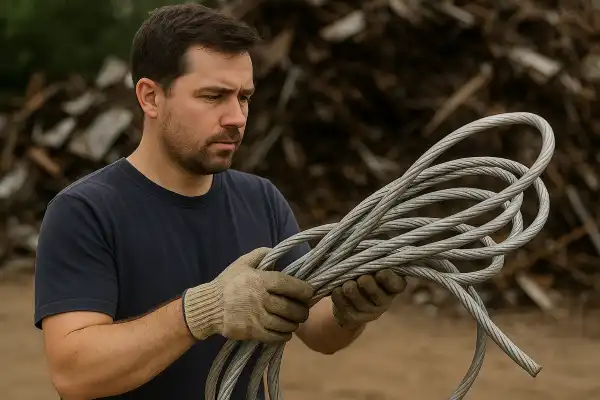What are the best metals to scrap for maximum profitability and environmental impact? This question drives countless conversations in recycling yards, construction sites, and workshops across the country. Understanding metal values isn’t just about quick cash—it’s about recognizing the complex interplay between global commodity markets, industrial demand, and sustainable resource management.
During my years transitioning from mechanical engineering to sustainability writing, I’ve witnessed how a single copper transformer can fund a weekend getaway, while a pile of aluminum cans barely covers lunch. Market dynamics shift constantly, but certain metals consistently deliver superior returns for savvy scrappers who understand quality grading and timing.
What are the best metals to scrap?
The most profitable metals to scrap in 2025 are copper, aluminum, brass, stainless steel, and precious metals, with copper leading the pack at $3-4 per pound for clean material. However, success in scrap metal recycling depends heavily on understanding metal grades, market conditions, and proper preparation techniques.

Copper: The premium choice for serious scrappers
Copper consistently ranks as the most valuable common scrap metal due to its excellent electrical conductivity and industrial demand, typically fetching $2-4 per pound depending on grade and market conditions. The metal’s reddish-brown color makes it easily identifiable, though older copper may appear darker with green oxidation spots.
Copper grades and their values:
- Bare bright copper wire: The highest grade, commanding top prices for clean, uncoated copper wire stripped of insulation
- #1 copper pipe: Clean, unalloyed copper plumbing materials free from attachments
- #2 copper: Burnt wire, lightly coated, or soldered copper with reduced value
Common sources include electrical wiring, plumbing pipes, air conditioning units, and electric motors. Professional electricians and plumbers often accumulate substantial quantities through renovation projects, making copper scrap a reliable income supplement.
Aluminum: Lightweight but lucrative
Aluminum commands $0.30-0.90 per pound, with the metal’s lightweight nature and widespread availability making it accessible to casual scrappers. Aluminum recycling saves up to 95% of the energy required for primary production, making it both economically and environmentally attractive.
High-value aluminum sources:
- Extruded aluminum from construction (window frames, gutters)
- Cast aluminum engine blocks and automotive parts
- Clean aluminum siding and roofing materials
- Electronic components from computers and gaming systems
Beverage cans represent the most accessible aluminum source, though they yield lower per-pound values. Despite modest individual value, aluminum cans demonstrate closed-loop recycling—recycled cans become new cans, creating sustainable circular resource flows.
Brass: The underestimated performer
Brass, a copper-zinc alloy, typically sells for $1.50-2.50 per pound, with value directly correlating to copper content. Clean, unalloyed brass with high copper content commands premium prices compared to contaminated or mixed brass materials.
Prime brass sources:
- Plumbing fixtures (faucets, valves, pipe fittings)
- Musical instruments (trumpets, saxophones, tubas)
- Decorative hardware (doorknobs, hinges, lighting fixtures)
- Industrial components (bearings, gears, electrical contacts)
Brass offers excellent corrosion resistance and machining properties, ensuring consistent industrial demand. Scrappers should focus on separation and cleaning to maximize returns.
Stainless steel: Heavy profits from common materials
Stainless steel scrap provides solid returns due to its chromium and nickel content, with different grades commanding varying prices based on alloy composition. Stainless steel value stems from containing other valuable metals including chromium (10% or more), nickel, molybdenum, and iron.
Valuable stainless steel sources:
- Kitchen appliances (refrigerators, dishwashers, ranges)
- Industrial equipment and food processing machinery
- Automotive exhaust systems and trim components
- Medical and laboratory equipment
Large appliances can yield $10-50 per unit, with weight being a significant factor in total returns. Proper identification of stainless steel grades requires magnet testing—true stainless steel shows minimal magnetic attraction.
Precious metals: Small quantities, substantial returns
Gold, silver, platinum, and palladium command exceptional per-ounce prices, with even tiny quantities from electronic components yielding significant returns, often exceeding $25 per pound for platinum.
Electronic scrap sources:
- Computer circuit boards and processors
- Catalytic converters (containing platinum, palladium, rhodium)
- Cell phones and smartphones
- Medical and laboratory equipment
Extracting precious metals from electronics requires specialized knowledge and safety precautions, but returns can exceed most other scrap metal categories. Professional electronics recyclers often provide better pricing than general scrap yards for these materials.
Lead: High value with safety considerations
Lead scrap proves extremely profitable when recycled, though pure sources remain difficult to locate and require strict safety protocols due to toxicity concerns. Common sources include automotive batteries, roofing materials, and radiation shielding components.
Proper lead handling requires protective equipment and specialized disposal methods. Many scrap yards impose specific requirements for lead acceptance due to environmental regulations.
Market timing and preparation strategies
Current market conditions show copper up 4% due to tight supply and import demand, while aluminum decreased 0.44% as global supply stabilizes. Smart metal processing can double or triple scrap metal prices through proper sorting and cleaning techniques.
Maximizing scrap value:
- Remove non-metal attachments (plastic, rubber, insulation)
- Sort materials by metal type and grade
- Clean materials to remove dirt, oil, and contamination
- Accumulate larger quantities to improve negotiating power
- Monitor market trends and timing sales strategically
Regional price variations can significantly impact returns, with some locations offering substantially better pricing for identical materials. Developing relationships with multiple local scrap yards provides leverage in price negotiations.
Conclusion
Three months ago, I processed a mixed load from a factory renovation that perfectly illustrated these principles. The job included forty pounds of clean copper tubing, sixty pounds of aluminum siding, and thirty pounds of brass valves. By separating materials properly and choosing the right buyer, that single afternoon’s work generated nearly $400—equivalent to my old hourly engineering rate. Quality preparation and market knowledge transformed what appeared to be industrial waste into substantial income while supporting sustainable resource cycling.

